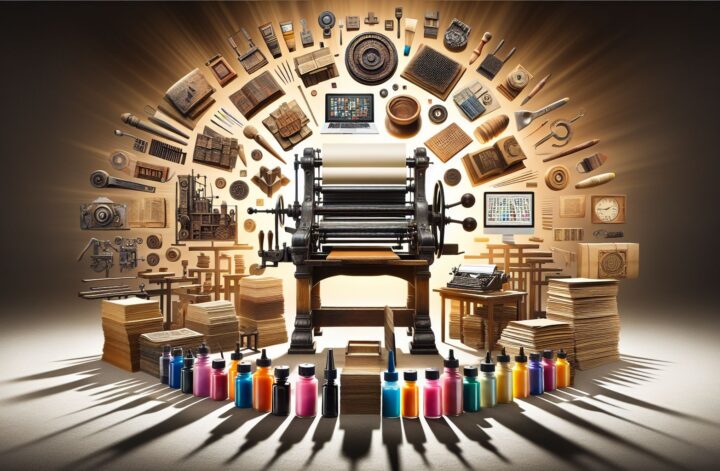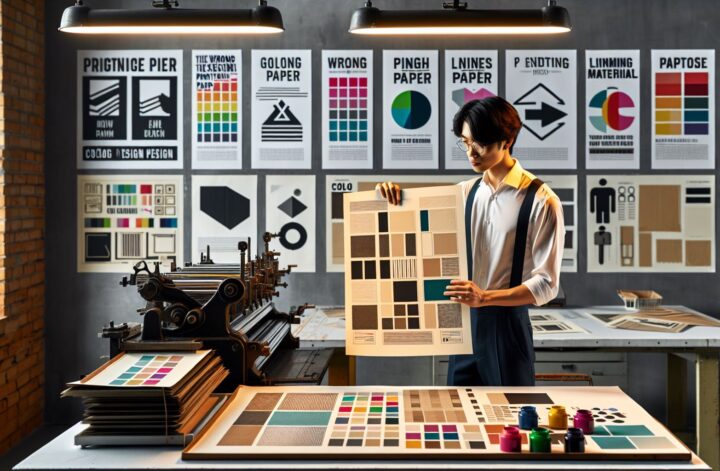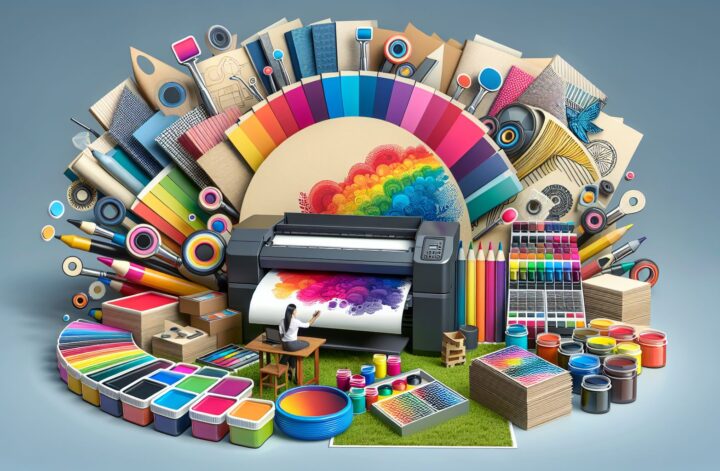In today’s competitive business landscape, effective marketing strategies are crucial for the growth and success of printing businesses. Whether you’re a small local print shop or a larger printing company, having a solid marketing plan in place can help you reach your target audience and stay ahead of the competition.
Marketing strategies for printing businesses encompass a wide range of activities, from traditional print marketing materials to digital marketing efforts. It is important to establish a strong online presence to attract potential customers who are increasingly relying on search engines and social media platforms for their purchasing decisions. Additionally, understanding your target audience and their preferences is key to crafting marketing messages that resonate with them.
Another factor that can greatly influence the effectiveness of marketing strategies for printing businesses is the customer experience. Providing excellent customer service and creating an enjoyable and seamless experience for your clients can lead to repeat business and loyal customers.
1. Focus on Potential Customers
To effectively market a printing business, it is crucial to focus on potential customers. Identifying ideal customers and understanding the target market can greatly enhance marketing efforts and ensure that messages are reaching the right audience.
The first step in focusing on potential customers is thorough research and analysis of the target audience. This involves gathering data on demographics, interests, and purchasing behaviors to gain a deeper understanding of their needs and preferences. By segmenting the market and identifying niche audiences, marketing efforts can be tailored to specific customer groups.
Creating customer profiles is another important step in focusing on potential customers. By developing detailed profiles that outline characteristics, preferences, and pain points, businesses can better align their products, services, and marketing messages to meet customer needs and expectations. This helps in crafting targeted and personalized marketing campaigns that resonate with potential customers.
2. Develop a Direct Mail Campaign
Developing a direct mail campaign for a printing business entails strategic planning and targeted creativity to effectively capture the attention of potential customers. The first step is to define the target audience and segment the market based on demographics, interests, and purchasing behaviors. By understanding their needs and preferences, businesses can craft personalized messages that resonate with potential customers.
An important aspect of a direct mail campaign is the use of eye-catching envelopes. Colored or uniquely shaped envelopes immediately grab the recipient’s attention and stand out among a sea of white envelopes. This can significantly increase the chances of the mail piece being opened and read.
Compelling headlines and engaging copywriting are essential components of a successful direct mail campaign. The headline should be concise but impactful, instantly capturing the reader’s attention and piquing their curiosity. The body copy should be persuasive, emphasizing the benefits and unique selling propositions of the printing business. A clear call-to-action encourages recipients to take action, whether it’s visiting the business’s website, calling for a consultation, or making a purchase.
To further maximize the results of a direct mail campaign, integration with online marketing funnels is crucial. Including personalized URLs (PURLs) or QR codes in the mail piece directs recipients to a dedicated landing page, where they can easily provide their contact information or make a purchase. This integration allows businesses to track and measure the effectiveness of their direct mail campaign, capturing leads and nurturing them through the sales funnel.
3. Utilize Search Engines and Local Listings
In today’s digital landscape, having a strong online presence is crucial for any business, including printing businesses. Utilizing search engines and local listings can greatly enhance online visibility and attract potential customers to your printing business.
Firstly, implementing search engine optimization (SEO) strategies can significantly improve your website’s ranking on search engine result pages. Conducting a thorough audit of your website helps identify any technical issues or areas for improvement. By optimizing your website’s content, meta tags, and URLs with relevant keywords, you increase the chances of appearing higher in organic search results. This drives organic internet traffic to your website and increases the likelihood of attracting potential customers.
Additionally, optimizing your Google My Business listing is essential for local search visibility. When users search for printing services in their local area, your business will appear in the highly visible “Local Pack” on Google’s search results page. This listing includes important information such as your business name, address, phone number, reviews, and website link. Ensuring this information is accurate and up-to-date increases the likelihood of potential customers choosing your printing business.
Furthermore, leveraging Google Adwords allows for targeted advertising that reaches the right audience at the right time. With Google Adwords, you can create and display relevant ads based on keywords related to printing services. This allows you to target your ideal customers and drive traffic to your website. By combining search engine optimization strategies with targeted advertising, you maximize your chances of attracting potential customers to your printing business.
4. Leverage Social Media Platforms to Reach Your Target Audience
In today’s digitally connected society, leveraging social media platforms, like the Scottsdale dentist did, is crucial for any business, including printing businesses, to reach their target audience. Social media platforms offer a vast potential customer base and provide an effective way to build brand awareness, engage with followers, and drive traffic to your printing business.
The first step is to select the right social media platforms based on the preferences and demographics of your potential customers. For example, if your target audience consists of young professionals and creatives, platforms like Instagram and Pinterest may be more effective. On the other hand, if your target audience is mostly professionals and businesses, LinkedIn and Twitter may be more suitable options.
Using social media as a listening tool allows you to understand your target audience’s needs, preferences, and challenges. By monitoring conversations, comments, and mentions related to printing services, you can gather valuable insights to tailor your marketing messages and services. Engaging with your followers consistently by responding to comments, questions, and direct messages helps build strong relationships and trust.
Moreover, social media platforms provide opportunities to showcase your printing business’s capabilities, share testimonials, and promote special offers. By creating visually appealing and engaging content, such as photos of high-quality prints or time-lapse videos of printing processes, you can attract the attention of potential customers and encourage them to explore your services.
5. Invest in Content Marketing Efforts
Investing in content marketing efforts is a crucial strategy for printing businesses to attract and retain an audience. By creating valuable, relevant, and consistent content, you can position yourself as an expert in the industry and establish trust with your target customers.
To start, identify relevant topics that align with your target audience’s interests and pain points. For example, you can create content about print design tips, choosing the right printing materials, or showcasing innovative print projects. By addressing these topics, you will provide value to your audience and demonstrate your expertise.
Optimizing your content for search engines (SEO) is essential to ensure that your target customers can find your content easily. Conduct keyword research to identify relevant keywords related to printing services and incorporate them naturally into your content. This will help improve your search engine rankings and increase your visibility online.
Consistency is key in content marketing. Regularly create and publish content to keep your audience engaged and informed. Consider creating a content calendar to plan and schedule your content in advance. Promote your content through various channels, such as social media, email marketing, and guest posting, to reach a wider audience and drive traffic back to your website.
6. Establish Collaborations with Other Companies
To expand your marketing efforts and reach a wider audience, collaborating with other companies can be a highly effective strategy. By partnering with complementary businesses in your local area or industry, you can leverage their customer base and resources to enhance your marketing initiatives. Here are a few ways to establish successful collaborations:
- Identify complementary businesses: Look for companies that offer products or services that align with yours but do not compete directly. For example, if you run a printing business, partnering with graphic designers or event planners can be mutually beneficial.
- Joint ventures: Create joint marketing campaigns or promotions where both businesses can benefit. For instance, you can collaborate with a local bakery to offer a discount coupon for their customers, while they promote your printing services in return.
- Cross-promotion: Feature each other’s products or services in your marketing materials, such as social media posts, newsletters, or blog articles. This way, you can tap into each other’s customer base and expand your reach.
- Networking and local business groups: Attend networking events and join local business organizations to meet potential collaboration partners. These groups provide a platform to connect with like-minded entrepreneurs and discover partnership opportunities that can benefit both parties.
Establishing collaborations with other businesses enables you to tap into new markets, access new customer segments, and create a win-win situation. By combining your resources and expertise, you can maximize your marketing efforts and achieve greater success in reaching your target audience.
7. Network and Build Relationships
Networking and building relationships in the printing industry can greatly contribute to the success and growth of your business. By connecting with other professionals, you can gain valuable insights, establish partnerships, and increase your visibility within the industry. Here are some strategies to effectively network and build relationships:
- Attend Industry Events and Trade Shows: Participate in industry events and trade shows to meet fellow professionals and potential clients. These events provide opportunities to engage in conversations, showcase your printing services, and form connections with individuals who share a common interest in the industry.
- Join Professional Organizations: Become a member of professional organizations and associations that are relevant to the printing industry. These groups often organize networking events and provide platforms for industry professionals to connect, collaborate, and exchange ideas.
- Collaborate with Other Businesses: Seek collaborations with complementary businesses, such as graphic designers or marketing agencies. By partnering with these professionals, you can expand your reach, access new customer bases, and tap into their expertise. Collaborative projects can include joint marketing campaigns, co-hosting events, or cross-promoting each other’s services.
- Attend Local Business Networking Groups: Join local business networking groups to connect with professionals from various industries. These groups allow you to build relationships, exchange referrals, and learn from other entrepreneurs. Word-of-mouth referrals and recommendations from fellow local businesses can greatly enhance your reputation and lead to new opportunities.
Remember, networking is not just about exchanging business cards. It is about establishing genuine connections, nurturing relationships, and providing value to others. By actively participating in industry events and engaging with professionals in your local networks, you can create a strong foundation for your printing business and open doors to new opportunities.
8. Participate in Trade Shows and Exhibitions
Participating in trade shows and exhibitions is a highly effective marketing strategy for printing businesses. These events offer a unique opportunity to reach a wide audience, showcase your products and services, and establish meaningful connections with potential clients.
One key benefit of participating in trade shows is the ability to create exclusive trade show signs that grab the attention of attendees. These signs can be customized to showcase your printing capabilities and highlight your unique selling points. By creating visually appealing and informative signage, you can make a lasting impression on visitors and stand out from the competition.
Additionally, trade shows provide the perfect platform for partnering with other businesses. By collaborating with complementary companies, such as graphic designers or marketing agencies, you can create mutually beneficial arrangements. For example, you can offer discounted printing services to their clients in exchange for them promoting your business at the trade show. This partnership not only expands your reach but also enhances the overall experience for attendees as they can access a wider range of services in one place.
9. Offer Free Samples or Coupons
One effective marketing strategy for printing businesses is to offer free samples or coupons to attract potential customers and incentivize purchases. By providing free samples, you give customers a chance to experience the quality and value of your printing services firsthand. This can help to build trust and increase their likelihood of making larger orders in the future.
You can implement this strategy through various channels. Online promotions can offer free samples, such as a set of business cards or a small flyer, to customers who sign up for your mailing list or make a purchase. This not only encourages them to try your printing services but also enables you to build a customer database for future marketing efforts.
Additionally, you can distribute printed coupons in person or through direct mail campaigns. Coupons can offer discounts or free upgrades on printing orders, which can entice potential customers to choose your business over competitors. This strategy not only attracts new customers but also encourages repeat business from existing customers.
10. Utilize Traditional Advertising Strategies
Traditional advertising strategies play a crucial role in the success of printing businesses. While digital marketing has gained significant popularity in recent years, traditional marketing methods continue to be effective in reaching potential customers. Incorporating a mix of traditional advertising strategies can result in a comprehensive and well-rounded marketing plan for printing businesses.
One essential traditional advertising strategy is outdoor marketing. This involves utilizing billboards, signage, and banners to promote your printing services. Placing strategically located advertisements in high-traffic areas can effectively capture the attention of potential customers.
Print marketing is another valuable traditional advertising strategy for printing businesses. This includes the distribution of brochures, flyers, and direct mail materials. By delivering printed marketing materials directly to target audiences, you can ensure your message reaches them in a tangible and engaging way.
Direct marketing is another effective traditional advertising strategy. This involves reaching out to potential customers directly through phone calls, emails, or physical mail. Direct marketing allows you to establish personal connections and customized communications with your target audience, increasing the likelihood of capturing their interest.
When it comes to electronic marketing, traditional methods such as radio and television advertising can still be impactful. Utilizing these channels to promote your scottsdale printing services can reach a wide range of potential customers who may not be actively searching on digital platforms.
Event marketing is a traditional advertising strategy that allows you to showcase your printing services at trade shows, conferences, or community events. Participating in such events provides an opportunity to directly engage with potential customers and showcase your expertise and offerings.

Conclusion
In conclusion, building a well-defined marketing strategy is crucial for the success of a printing company. It is important to go beyond basic printing services and offer specialty printing services to cater to a niche audience and differentiate oneself from competitors. Furthermore, articulating a memorable proposition is essential to stand out in a crowded market. This can be achieved through effective branding and design, creating consistent and visually appealing marketing collateral. By investing in a strong marketing strategy that incorporates these elements, a printing company can effectively reach its target audience, build brand awareness, and ultimately drive growth and profitability.











